ORDER
Passeriformes
FAMILY
Passeridae
GENUS & SPECIES
KEY FEATURES
• A seed-eating bird of savannah and farmland
• Male weaves a spherical nest from strips of grass in order to attract a mate
• After inspecting a number of nests, the female breeds with the owner of the nest that meets her approval
• Outside of the breeding season, the male loses his bright coloration
WHERE IN THE WORLD?
Nonmigrant; lives in Africa, south of the Sahara Desert, often near cultivated land; common in tropics, and also found on the eastern side of the continent as far south as Cape Province

LIFECYCLE
During the breeding season, the nesting site of the village weaver is a scene of noisy activity, as brightly colored males hang beneath their nests competing for females.
HABITAT
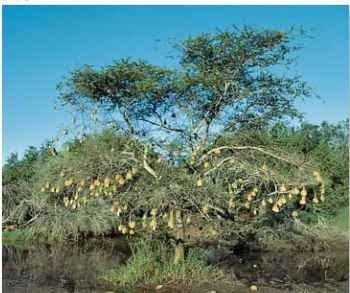
A Strange fruit Overhanging branches are popular nesting sites.
There are two subspecies of village weaver: one with a black hood, one without. Both live in open, semiwooded habitats from the fringes of the Sahara to the grasslands of South Africa. The bird needs a supply of palm leaves that it can strip and use to build its nest.The village weaver often lives on arable land, but avoids dense forests and arid areas. It often lives near rivers and streams, nesting on branches overhanging the water or among tall reeds.
CONSERVATION
The village weaver has not been seriously affected by human changes to Africa’s landscapes, and is not endangered. In some places the clearing of forests for cultivation has actually helped the species to spread.The village weaver is occasionally trapped as a pest, and where it is very numerous its nests are sometimes destroyed. However, such measures have had little effect on its overall numbers.
BEHAVIOR
The weaver is a social bird, not only breeding in colonies but feeding in flocks. Flocking helps the weaver locate food that is often widely scattered and offers a measure of safety. Roosting and feeding sites are busy as birds squabble over partners and pickings.
Such a social lifestyle requires good communication, and the village weaver has a repertoire of at least 15 calls. Some are understood only by the same species, but a few can be recognized by other small birds. While on the move, the weaver keeps up a constant chuck-chuck that helps the flock stay together; and chirps excitedly to announce the discovery of food. It is particularly vocal during the breeding season, chattering to court partners or to deter rivals. But every so often, the colony suddenly falls silent.
Splash down Regular bathing removes dust from plumage.

The village weaver gets its name from its habit of nesting near settlements.
Weavers sometimes nest in the same trees as wasps; this helps deter predators.
The female rejects any egg that looks unlike the rest of her clutch. This is probably a defensive tactic against a cuckoo that lays its egg in weaver nests.
BREEDING
The rains, which fall at different times of the year across its range, are the cue for the male to seek a clear branch and begin building a nest from strips of grass.The ball-shaped mass appears impenetrable, but there is an entrance to the chamber underneath.
Having attracted and mated with a female, the male takes little interest in the rest of the proceedings, and often begins building another nest elsewhere.The female incubates the eggs and rears the young alone. The eggs hatch after about two weeks, and roughly three weeks later the nestlings are independent.
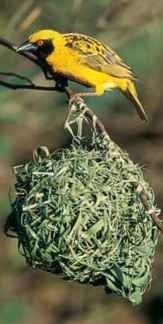
A Busy builder
A male may weave three nests in breeding season.
FOOD & FEEDING
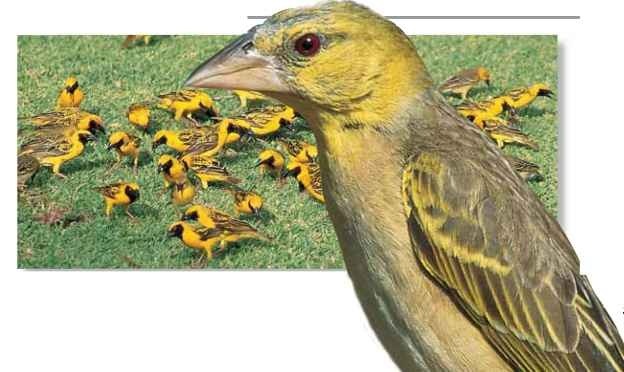
A safe enough to eat
By feeding on the ground with a large flock, each weaver stands a better chance of escaping predators. These include birds of prey, such as goshawks.
BUILDING A SHOW HOME

Collecting materials…
The male tears off pieces of green grass or palm leaves, and then carries them back to the nest tree.
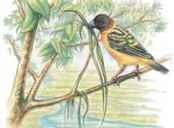
Foundations…
The first strands are draped over a branch.The male coils them and pulls them tight.
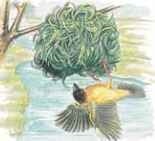
Ready for viewing…
With his nest complete, the male carries out a courtship display to attract female visitors to the nest.

Inspection
Satisfied with the nest (shown in cross section), a female lines it and lays her eggs.
The village weaver feeds mainly at or near ground level on the seeds of grasses and other low-growing plants. It may feed on seed crops, such as millet, but rarely to the extent of being a serious pest.
The village weaver also eats nsects, especially during the breeding season, when nestlings need plenty of energy and protein. With its stout yet fine-tipped bill, the weaver can manipulate morsels easily, whether gathering insects for nestlings or cracking tough seed husks.
PROFILE
Village Weaver
The lightweight build, strong feet and pointed bill of the village weaver enable it to hang adroitly while threading the first grass strips of its nest.

CREATURE COMPARISONS
Like the village weaver, the chestnut weaver (Ploceus rubiginosus) lives in Africa.There are two separate populations: one in the east, the other in the southwest. Both species have powerful feet that help them grip branches while they weave their intricate nests. Similarly the male of both species takes on a more brilliant coloration during the breeding season: the male chestnut weaver becomes reddish, while the female remains a dull brown. Like the village weaver, the chestnut weaver is sociable, often gathering in large flocks of up to 500 individuals.

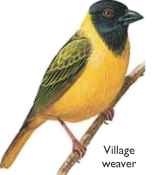
| VITAL | |
| STATISTICS | |
| Weight | About 1.5 oz. |
| Length | 7″ |
| Wingspan | 10″ |
| Sexual Maturity | 1 year |
| Breeding Season | Varies by location, but often coincides with rainy season |
| Number of Eggs | 2 or 3 |
| Incubation Period | 13 days |
| Fledging Period | 18 days |
| Breeding Interval | 1 year |
| Typical Diet | Seeds and insects |
| Lifespan | About 5 years |
RELATED SPECIES
• The village weaver is 1 of more than 100 species in the subfamily Ploceinae. Most live in Africa, but a handful lives in southern Asia. All true weavers build woven nests and breed in noisy colonies, and most are highly social. The weaver family also includes three other subfamilies. One of the species within a subfamily, the sociable weaver, makes nests that can be over 25′ across.

